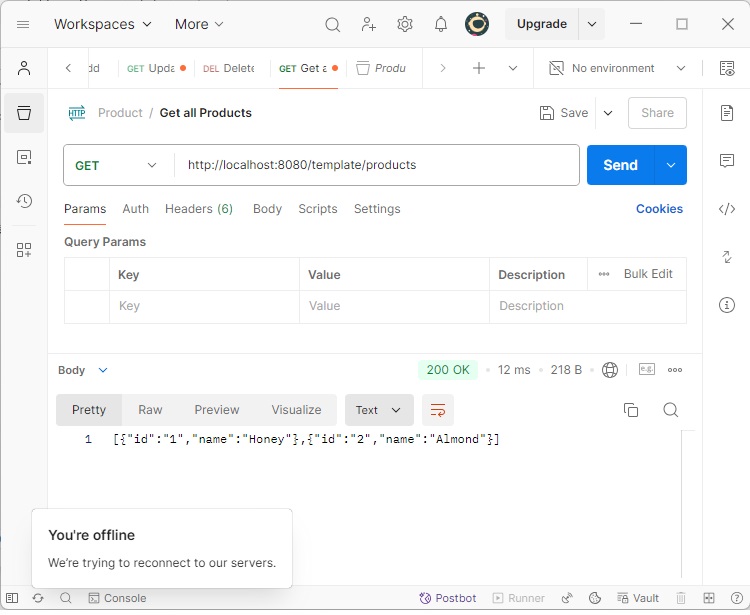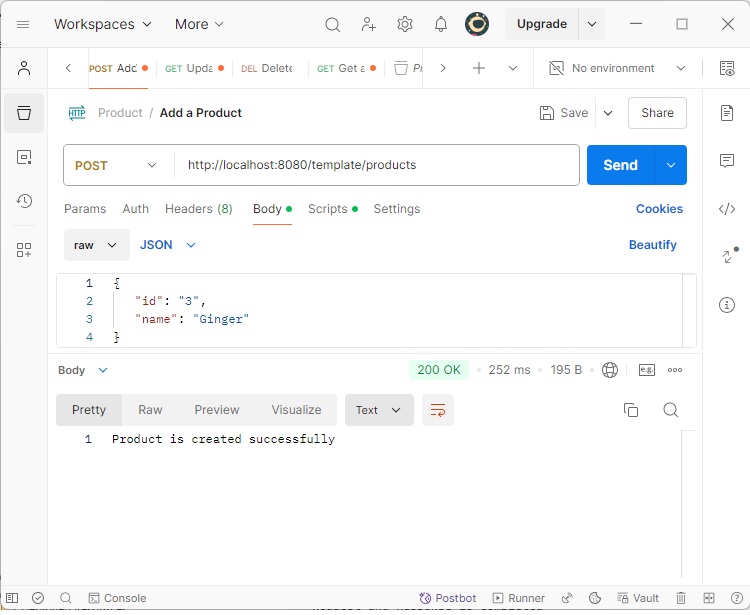
- Spring Boot 教程
- Spring Boot - 主页
- Spring Boot - 简介
- Spring Boot - 快速入门
- Spring Boot - 引导
- Spring Boot - Tomcat 部署
- Spring Boot - 构建系统
- Spring Boot - 代码结构
- Spring Bean 和依赖注入
- Spring Boot - 跑步者
- Spring Boot - 应用程序属性
- Spring Boot - 日志记录
- 构建 RESTful Web 服务
- Spring Boot - 异常处理
- Spring Boot - 拦截器
- Spring Boot - Servlet 过滤器
- Spring Boot - Tomcat 端口号
- Spring Boot - Rest 模板
- Spring Boot - 文件处理
- Spring Boot - 服务组件
- Spring Boot - Thymeleaf
- 使用 RESTful Web 服务
- Spring Boot - CORS 支持
- Spring Boot - 国际化
- Spring Boot - 调度
- Spring Boot - 启用 HTTPS
- Spring Boot-Eureka 服务器
- 向 Eureka 注册服务
- Zuul代理服务器和路由
- Spring Cloud配置服务器
- Spring Cloud 配置客户端
- Spring Boot - 执行器
- Spring Boot - 管理服务器
- Spring Boot - 管理客户端
- Spring Boot - 启用 Swagger2
- Spring Boot - 创建 Docker 镜像
- 追踪微服务日志
- Spring Boot - Flyway 数据库
- Spring Boot - 发送电子邮件
- Spring Boot-Hystrix
- Spring Boot - Web Socket
- Spring Boot - 批量服务
- Spring Boot-Apache Kafka
- Spring Boot - Twilio
- Spring Boot - 单元测试用例
- 休息控制器单元测试
- Spring Boot - 数据库处理
- 保护 Web 应用程序的安全
- Spring Boot - 使用 JWT 的 OAuth2
- Spring Boot - Google 云平台
- Spring Boot - Google OAuth2 登录
- Spring Boot 资源
- Spring Boot - 快速指南
- Spring Boot - 有用的资源
- Spring Boot - 讨论
Spring Boot - Rest 模板
Rest 模板用于创建使用 RESTful Web 服务的应用程序。您可以使用Exchange()方法来使用所有 HTTP 方法的 Web 服务。下面给出的代码显示了如何为 Rest Template 创建 Bean 以自动装配 Rest Template 对象。
package com.tutorialspoint.demo;
import org.springframework.boot.SpringApplication;
import org.springframework.boot.autoconfigure.SpringBootApplication;
import org.springframework.context.annotation.Bean;
import org.springframework.web.client.RestTemplate;
@SpringBootApplication
public class DemoApplication {
public static void main(String[] args) {
SpringApplication.run(DemoApplication.class, args);
}
@Bean
public RestTemplate getRestTemplate() {
return new RestTemplate();
}
}
得到
使用 RestTemplate - Exchange() 方法使用 GET API
假设此 URL http://localhost:8080/products返回以下 JSON,我们将使用 Rest Template 使用以下代码来使用此 API 响应 -
[
{
"id": "1",
"name": "Honey"
},
{
"id": "2",
"name": "Almond"
}
]
您必须遵循给定的要点来使用 API -
- 自动装配 Rest 模板对象。
- 使用 HttpHeaders 设置请求标头。
- 使用 HttpEntity 来包装请求对象。
- 提供 Exchange() 方法的 URL、HttpMethod 和返回类型。
@RestController
public class ConsumeWebService {
@Autowired
RestTemplate restTemplate;
@RequestMapping(value = "/template/products")
public String getProductList() {
HttpHeaders headers = new HttpHeaders();
headers.setAccept(Arrays.asList(MediaType.APPLICATION_JSON));
HttpEntity <String> entity = new HttpEntity<String>(headers);
return restTemplate.exchange("
http://localhost:8080/products", HttpMethod.GET, entity, String.class).getBody();
}
}
邮政
使用 RestTemplate - Exchange() 方法使用 POST API
假设此 URL http://localhost:8080/products返回如下所示的响应,我们将使用 Rest 模板使用此 API 响应。
下面给出的代码是请求正文 -
{
"id":"3",
"name":"Ginger"
}
下面给出的代码是响应主体 -
Product is created successfully
您必须遵循以下几点才能使用 API -
自动装配 Rest 模板对象。
使用 HttpHeaders 设置请求标头。
使用 HttpEntity 来包装请求对象。在这里,我们包装 Product 对象以将其发送到请求正文。
提供 Exchange() 方法的 URL、HttpMethod 和返回类型。
@RestController
public class ConsumeWebService {
@Autowired
RestTemplate restTemplate;
@RequestMapping(value = "/template/products", method = RequestMethod.POST)
public String createProducts(@RequestBody Product product) {
HttpHeaders headers = new HttpHeaders();
headers.setAccept(Arrays.asList(MediaType.APPLICATION_JSON));
HttpEntity<Product> entity = new HttpEntity<Product>(product,headers);
return restTemplate.exchange(
"http://localhost:8080/products", HttpMethod.POST, entity, String.class).getBody();
}
}
放
使用 RestTemplate - Exchange() 方法使用 PUT API
假设此 URL http://localhost:8080/products/3返回以下响应,我们将使用 Rest Template 来使用此 API 响应。
下面给出的代码是请求正文 -
{
"name":"Indian Ginger"
}
下面给出的代码是响应主体 -
Product is updated successfully
您必须遵循以下几点才能使用 API -
自动装配 Rest 模板对象。
使用 HttpHeaders 设置请求标头。
使用 HttpEntity 来包装请求对象。在这里,我们包装 Product 对象以将其发送到请求正文。
提供 Exchange() 方法的 URL、HttpMethod 和返回类型。
@RestController
public class ConsumeWebService {
@Autowired
RestTemplate restTemplate;
@RequestMapping(value = "/template/products/{id}", method = RequestMethod.PUT)
public String updateProduct(@PathVariable("id") String id, @RequestBody Product product) {
HttpHeaders headers = new HttpHeaders();
headers.setAccept(Arrays.asList(MediaType.APPLICATION_JSON));
HttpEntity<Product> entity = new HttpEntity<Product>(product,headers);
return restTemplate.exchange(
"http://localhost:8080/products/"+id, HttpMethod.PUT, entity, String.class).getBody();
}
}
删除
使用 RestTemplate - Exchange() 方法使用 DELETE API
假设此 URL http://localhost:8080/products/3返回下面给出的响应,我们将使用 Rest Template 来使用此 API 响应。
下面显示的这行代码是响应主体 -
Product is deleted successfully
您必须遵循以下几点才能使用 API -
自动装配 Rest 模板对象。
使用 HttpHeaders 设置请求标头。
使用 HttpEntity 来包装请求对象。
提供 Exchange() 方法的 URL、HttpMethod 和返回类型。
@RestController
public class ConsumeWebService {
@Autowired
RestTemplate restTemplate;
@RequestMapping(value = "/template/products/{id}", method = RequestMethod.DELETE)
public String deleteProduct(@PathVariable("id") String id) {
HttpHeaders headers = new HttpHeaders();
headers.setAccept(Arrays.asList(MediaType.APPLICATION_JSON));
HttpEntity<Product> entity = new HttpEntity<Product>(headers);
return restTemplate.exchange(
"http://localhost:8080/products/"+id, HttpMethod.DELETE, entity, String.class).getBody();
}
}
完整的 Rest 模板控制器类文件如下 -
package com.tutorialspoint.demo.controller;
import java.util.Arrays;
import org.springframework.beans.factory.annotation.Autowired;
import org.springframework.http.HttpEntity;
import org.springframework.http.HttpHeaders;
import org.springframework.http.HttpMethod;
import org.springframework.http.MediaType;
import org.springframework.web.bind.annotation.PathVariable;
import org.springframework.web.bind.annotation.RequestBody;
import org.springframework.web.bind.annotation.RequestMapping;
import org.springframework.web.bind.annotation.RequestMethod;
import org.springframework.web.bind.annotation.RestController;
import org.springframework.web.client.RestTemplate;
import com.tutorialspoint.demo.model.Product;
@RestController
public class ConsumeWebService {
@Autowired
RestTemplate restTemplate;
@RequestMapping(value = "/template/products")
public String getProductList() {
HttpHeaders headers = new HttpHeaders();
headers.setAccept(Arrays.asList(MediaType.APPLICATION_JSON));
HttpEntity<String> entity = new HttpEntity<String>(headers);
return restTemplate.exchange(
"http://localhost:8080/products", HttpMethod.GET, entity, String.class).getBody();
}
@RequestMapping(value = "/template/products", method = RequestMethod.POST)
public String createProducts(@RequestBody Product product) {
HttpHeaders headers = new HttpHeaders();
headers.setAccept(Arrays.asList(MediaType.APPLICATION_JSON));
HttpEntity<Product> entity = new HttpEntity<Product>(product,headers);
return restTemplate.exchange(
"http://localhost:8080/products", HttpMethod.POST, entity, String.class).getBody();
}
@RequestMapping(value = "/template/products/{id}", method = RequestMethod.PUT)
public String updateProduct(@PathVariable("id") String id, @RequestBody Product product) {
HttpHeaders headers = new HttpHeaders();
headers.setAccept(Arrays.asList(MediaType.APPLICATION_JSON));
HttpEntity<Product> entity = new HttpEntity<Product>(product,headers);
return restTemplate.exchange(
"http://localhost:8080/products/"+id, HttpMethod.PUT, entity, String.class).getBody();
}
@RequestMapping(value = "/template/products/{id}", method = RequestMethod.DELETE)
public String deleteProduct(@PathVariable("id") String id) {
HttpHeaders headers = new HttpHeaders();
headers.setAccept(Arrays.asList(MediaType.APPLICATION_JSON));
HttpEntity<Product> entity = new HttpEntity<Product>(headers);
return restTemplate.exchange(
"http://localhost:8080/products/"+id, HttpMethod.DELETE, entity, String.class).getBody();
}
}
Spring Boot 应用程序类 - DemoApplication.java 的代码如下 -
package com.tutorialspoint.demo;
import org.springframework.boot.SpringApplication;
import org.springframework.boot.autoconfigure.SpringBootApplication;
@SpringBootApplication
public class DemoApplication {
public static void main(String[] args) {
SpringApplication.run(DemoApplication.class, args);
}
}
Maven 构建的代码 - pom.xml 如下 -
<?xml version = "1.0" encoding = "UTF-8"?>
<project xmlns = "http://maven.apache.org/POM/4.0.0"
xmlns:xsi = "http://www.w3.org/2001/XMLSchema-instance"
xsi:schemaLocation = "http://maven.apache.org/POM/4.0.0
http://maven.apache.org/xsd/maven-4.0.0.xsd">
<modelVersion>4.0.0</modelVersion>
<groupId>com.tutorialspoint</groupId>
<artifactId>demo</artifactId>
<version>0.0.1-SNAPSHOT</version>
<packaging>jar</packaging>
<name>demo</name>
<description>Demo project for Spring Boot</description>
<parent>
<groupId>org.springframework.boot</groupId>
<artifactId>spring-boot-starter-parent</artifactId>
<version>1.5.8.RELEASE</version>
<relativePath/>
</parent>
<properties>
<project.build.sourceEncoding>UTF-8</project.build.sourceEncoding>
<project.reporting.outputEncoding>UTF-8</project.reporting.outputEncoding>
<java.version>1.8</java.version>
</properties>
<dependencies>
<dependency>
<groupId>org.springframework.boot</groupId>
<artifactId>spring-boot-starter-web</artifactId>
</dependency>
<dependency>
<groupId>org.springframework.boot</groupId>
<artifactId>spring-boot-starter-test</artifactId>
<scope>test</scope>
</dependency>
</dependencies>
<build>
<plugins>
<plugin>
<groupId>org.springframework.boot</groupId>
<artifactId>spring-boot-maven-plugin</artifactId>
</plugin>
</plugins>
</build>
</project>
Gradle Build 的代码 - build.gradle 如下 -
buildscript {
ext {
springBootVersion = '1.5.8.RELEASE'
}
repositories {
mavenCentral()
}
dependencies {
classpath("org.springframework.boot:spring-boot-gradle-plugin:${springBootVersion}")
}
}
apply plugin: 'java'
apply plugin: 'eclipse'
apply plugin: 'org.springframework.boot'
group = 'com.tutorialspoint'
version = '0.0.1-SNAPSHOT'
sourceCompatibility = 1.8
repositories {
mavenCentral()
}
dependencies {
compile('org.springframework.boot:spring-boot-starter-web')
testCompile('org.springframework.boot:spring-boot-starter-test')
}
您可以创建可执行 JAR 文件,并使用以下 Maven 或 Gradle 命令运行 Spring Boot 应用程序 -
对于 Maven,您可以使用下面给出的命令 -
mvn clean install
“BUILD SUCCESS”后,您可以在目标目录下找到JAR文件。
对于 Gradle,您可以使用下面所示的命令 -
gradle clean build
“BUILD SUCCESSFUL”后,您可以在build/libs目录下找到JAR文件。
现在,使用以下命令运行 JAR 文件 -
java –jar <JARFILE>
现在,应用程序已在 Tomcat 端口 8080 上启动。

现在在 POSTMAN 应用程序中点击以下 URL,您可以看到输出。
通过 Rest 模板获取产品 - http://localhost:8080/template/products

创建产品 POST - http://localhost:8080/template/products

更新产品 PUT - http://localhost:8080/template/products/3

删除产品 - http://localhost:8080/template/products/3
